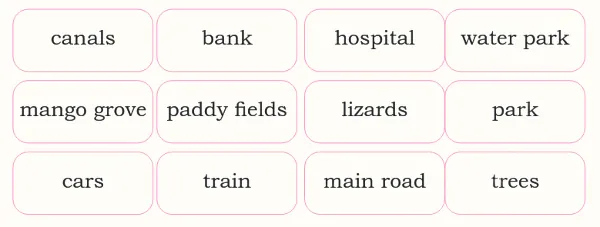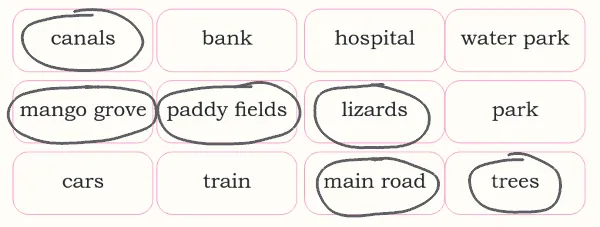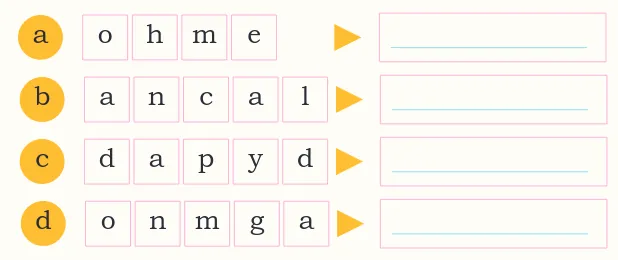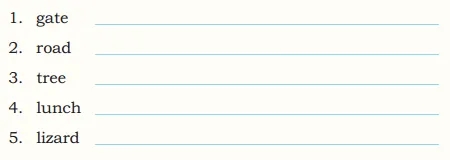Summary of Chapter 6: “Between Home and School”
The NCERT Class 2 English chapter “Between Home and School” is about the joy of everyday journeys and the experiences of childhood adventures. In this chapter, Ravi, a young boy in Class 2, describes his fun-filled journey to school each day. He walks with his friend through paddy fields and a mango grove, taking the shortest route to school. Along the way, they enjoy nature, jump over canals, climb trees, swing from branches, and observe garden lizards. The chapter highlights the joys of discovering nature and encourages students to notice the interesting things they see between home and school.
Chapter 6: Between Home and School – Questions and Answers
Let us speak
A. What time do you leave home for school? At what time does your school start?
Answer: I leave home at ___ and my school starts at ___.
e.g: I leave home at 8 am and my school starts at 9 am.
B. Tell your classmates about the fun you had on your way to school.
Answer: Share a personal story, such as seeing birds, trees, or playing with friends on the way to school.
C. Listen to the words that your teacher will read out. Point to the object that represents the word.

Answer: Practice saying these words with your teacher. Pay attention to the pronunciation.
Let us write
A. Write ‘ch’ to fill in the blanks. Read the sentences aloud.
- Today I have brought upma for lun__.
- My friend Unni loves to eat banana __ips.
- Our Tea__er put up a new __art in the classroom. It is on the wall behind her __air.
Answer:
- Today I have brought upma for lunch.
- My friend Unni loves to eat banana chips.
- Our Teacher put up a new chart in the classroom. It is on the wall behind her chair.
Let us draw
A. In the box draw the route from your home to your school.

Note: Your drawing doesn’t have to be perfect. The most important thing is to use your imagination and have fun!
Let us write
A. Circle all the things that Ravi and his friend see on their way to school.

Answer:

B. Answer the following questions.
1. Name some interesting things you see everyday between your home and your school.
Answer: I see trees, birds, a playground, and sometimes dogs and cats on my way to school.
2. Ask among your family members as to who had gone on a very long journey. Write a few sentences on
– where they had gone
– which mode of transport they used for going and for returning.
Answer:
- Example 1: My father once traveled to Delhi. He went by train and returned by airplane. He enjoyed the sights and met many people along the way.
- Example 2: I asked my grandfather about his longest journey. He told me about his trip to Kerala. He took a train journey to reach Kerala. He saw many interesting sights along the way, including lush green fields, mountains, and rivers. After his trip, he returned home by the same train.
3. Rearrange the jumbled letters to form words.
Hint: The words are from the lesson.

Answer: (Sample words based on the lesson)
- o h m e → home
- a n c a l → bank
- d a p y d → pad
- o n m g a → mango
Let us do
A. Make sentences using the words given below.

Answer:
- Gate: The gate of my school is big and green.
- Road: I walk on the road carefully while going to school.
- Tree: There is a tall tree near my house.
- Lunch: I eat my lunch with my friends during break time.
- Lizard: I saw a small lizard on the wall.
B. Cut out the picture of a vehicle from an old magazine or newspaper or poster. Bring it to the class. All of you can paste them on a large sheet of paper.
Write the name of the vehicle under each picture.
Answer: This is a hands-on activity. Find a picture of a vehicle from an old magazine or newspaper, cut it out, and bring it to class.
Complete NCERT Solutions for Class 2 English(Mridang)
| NCERT Solutions | Unit-wise List | Chapter-wise Solutions |
|---|---|
| Unit 1: Fun with Friends | 1. My Bicycle Solutions 2. Picture Reading Solutions |
| Unit 2: Welcome to My World | 3. It Is Fun Solutions 4. Seeing without Seeing Solutions |
| Unit 3: Going Places | 5. Come Back Soon Solutions 7. This is My Town Solutions |
| Unit 4: Life Around Us | 8. A Show of Clouds Solutions 9. My Name Solutions 10. The Crow Solutions 11. The Smart Monkey Solutions |
| Unit 5: Harmony | 12. Little Drops of Water Solutions 13. We Are All Indians Solutions |
Conclusion
“Between Home and School” encourages students to appreciate the natural environment around them. Through Ravi’s journey, children learn to observe their surroundings, understand the joy of exploration, and express their experiences creatively. This chapter is a great way to foster curiosity and connection with nature in young learners.
Frequently Asked Questions – Between Home and School
In the story “Between Home and School,” a young boy named Ravi enjoys his daily walk to school. He loves exploring the beautiful nature around him, including lush green fields, mango groves, and canals. He also enjoys spotting animals like garden lizards. The story teaches us to appreciate the simple joys of life and to be mindful of the natural world.
We go to school to learn and grow. We learn important subjects like reading, writing, math, science, and history. School helps us become smart, kind, and responsible citizens. It’s also a place to make friends and learn to work together.
The chapter “Between Home and School” in CBSE Class 2 English introduces children to a delightful journey that they can relate to. It captures the experiences and observations of a child as they travel from home to school, fostering an understanding of their surroundings and enhancing their language skills.
Children can learn to appreciate the beauty of nature, the joy of simple pleasures, and the importance of observing their surroundings. They can also develop a sense of curiosity and wonder about the world around them.
